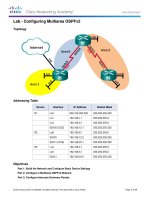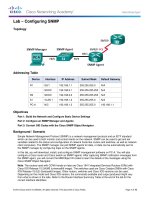27 introducing VPN solutions kho tài liệu bách khoa
Bạn đang xem bản rút gọn của tài liệu. Xem và tải ngay bản đầy đủ của tài liệu tại đây (621.11 KB, 11 trang )
Introducing VPN Solutions
BSCI v3.0—2-1
VPN Taxonomy
VPN Models
VPN services can be offered based on two major
models:
• Overlay VPNs, in which the service provider provides virtual
point-to-point links between customer sites
• Peer-to-peer VPNs, in which the service provider participates
in the customer routing
What Is a VPN?
Virtual: Information within a private network is transported
over a public network.
Private: The traffic is encrypted to keep the data confidential.
Benefits of VPN
Cost
Security
Scalability
Site-to-Site VPNs
Site-to-site VPN: extension of classic WAN
Remote-Access VPNs
Remote-access VPN: evolution of dial-in networks and ISDN
Generic Routing Encapsulation
OSI Layer 3 tunneling protocol:
• Uses IP for transport
• Uses an additional header to support any other OSI Layer 3
protocol as payload (e.g., IP, IPX, AppleTalk)
Default GRE Characteristics
• Tunneling of arbitrary OSI Layer 3 payload is the primary goal
of GRE
• Stateless (no flow control mechanisms)
• No security (no confidentiality, data authentication, or
integrity assurance)
• 24-byte overhead by default (20-byte IP header and 4-byte
GRE header)
GRE Configuration Example
• GRE tunnel is up and protocol up if:
– Tunnel source and destination are configured
– Tunnel destination is in routing table
– GRE keepalives are received (if used)
• GRE is the default tunnel mode.









